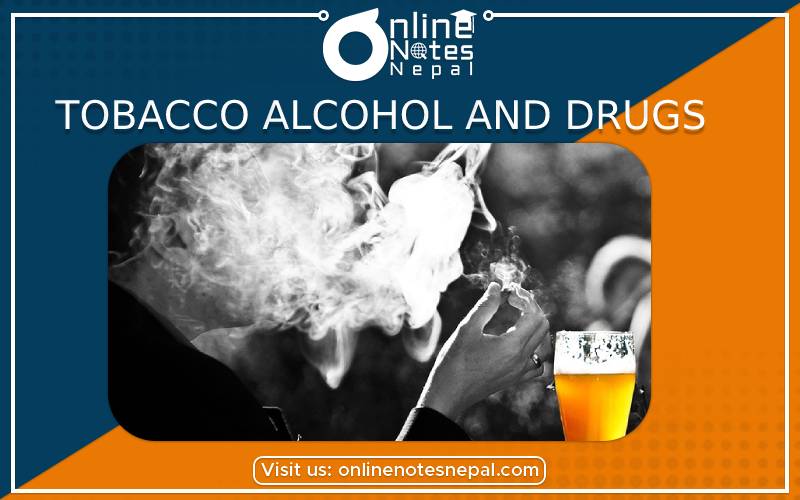Published by: Nuru
Published date: 10 Jan 2022

Smoking is the use of tobacco in the form of smoke; however, tobacco can be taken by chewing. Tobacco is one of the important causative agents of various diseases. Taking tobacco has no benefits to our health. Nicotine and other carcinogenic chemicals affect various parts of our body. It is the causative factors of high BP, heart disease, strokes, asthma, cough and cancer. The productivity of person is lost as it causes the chronic diseases.
Causes
Effects are of two types:
Immediate effects
Long-term effects of Tobacco chewing and smoking are:
Preventive measures of smoking are:
Effect of Nicotine:
1.Stimulate the conduction of nerve impulses.
2.Stimulate adrenal medulla to secrete adrenaline hormone.
3.Increase rate of heart beat and blood pressure.
Ethyl alcohol and alcohol is among the most commonly substances by human. Alcohol is manufactured by fermentation of sugar an organism like yeast.
Alcohol addiction: The prolonged use of alcohol may lead the dependence of the body on it is called alcohol addiction.
The reasons of alcohol addiction are:
1.Feeling of independence.
2.Overcoming frustration, failures and disappointments.
3.Desire of Excitement and to do more work.
4.Relief from pain and worries.
5.Curiosity and use of drink in social, cultural and religious function.
Effects of alcohol drinks:
1.Ill-effects alcoholic drinks on individual and health:
Alcohol causes ill effects on various organs like on
a.Nervous system: Loss of will power, self control and judgment.
b.On stomach: Alcohol causes secretion of gastric juices which causes gastritis problem.
c.On liver: Liver changes alcohol in to highly toxic compound, which may the cause of death.
d.On heart: It increases the blood pressure and adversely affect on function of hearth.
e.On kidney: Alcohl interferes with the normal functioning of nephrons in kidney.
f.Alcohol lowers the blood sugar level.
g.On reproduction: In women, it particularly affects the ovulation and menstrual cycle.
2. Ill-effects of alcoholic drinks on family:
Alcohol drinking has a socio-economic impact because excessive drinking or alcoholism affects the family, growth and development of children adversely.
3.Ill-effects of alcoholic drinks on community or society:
Social crimes like corruption, rapes, accident, loss of social reputation and personality.
Symptoms of alcoholism:
Loss of will power, self-control, judgment and emotional control.
Visual problem like blurred vision , double vision and improper judgment of distances.
Leads to neuritis, amnesia, gastritis.
Increase the blood pressure and lower the sugar level.
In women it effect on menstrual cycle.
Control of alcoholism:
Drugs are the chemical elements which directly harm the nervous system and brain with stimulating effects. As a result, organs get neither relaxed nor excited. WHO has defined drugs as ‘any chemical entity or mixture of entities, other than those required for the maintenance of normal health, the administration of which alters the biological function and possibly, structure’
Classification of drugs
Drugs are classified into three general categories based on their primary effects on human on the human body:
These are the substances, which suppress vital body function especially those of the brain and its parts. As such, they dull the mind and slow down body reactions, which often lead to accidental death and suicides. The depressants include the narcotics, barbiturates, tranquillizers, alcohol and the volatile solvents.
These drugs produce opposite effects to that depressants. Instead of bringing about relaxation and sleep, they produced increased mental alertness, reduce hunger and provide the feeling of well being. Hence, they have the slang name ‘uppers’, ‘pep pills’ and ‘lid poppers’. Stimulants such as cocaine, amphetamines, nicotine and caffeine are some of the substances with great potential abuse.
These constitute a variety of mind-alerting drugs, which distort reality, thinking and perception of time, sound, space and sensation. Thus they produce hallucinations, which at a time can be bizarre and mimic insanity. Experiences may be predicting whether a trip will be good or bad. Varying reaction depends on several factors like the mindset, setting, dose, quantity of the drug used.
Causes
Effects
Preventive measures